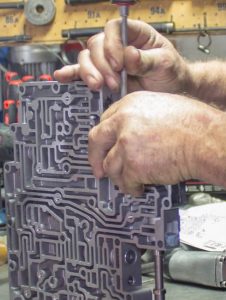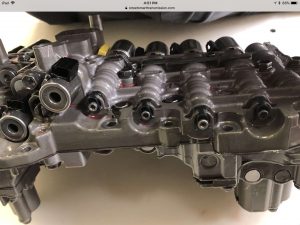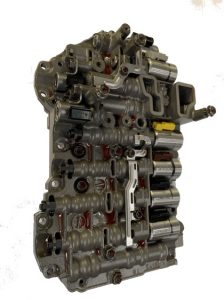So a mechanic just told you that you have valve body problems, and you’re going to have to spend a bunch of money on a transmission repair that you don’t fully understand. At this point, you have several options: Get a used valve body from a junkyard, have your existing valve body rebuilt, buy a remanufactured valve body, or call your super-rich uncle and beg him to buy you a new Rolls-Royce. Of course option number four would be great. But since most of us aren’t related to Daddy Warbucks, you’ve got to figure out a more practical solution to your valve body problems. So let’s take a closer look
What Transmission Do I Have?

First things first: What is a transmission valve body?
It’s not uncommon to hear the valve body referred to as the “brain of a transmission”. This is because the fluid channels  inside of the casting sort of resemble a human brain. These channels also control the operation of the transmission by routing pressurized hydraulic fluid (a.k.a. transmission fluid) down the correct path to engage a particular gear. This hydraulic pressure is created by the transmission pump, which is powered by rotational force coming from the engine crankshaft. Valves inside of the valve body then regulate this hydraulic pressure, and use it to operate the clutch packs/transmission bands that actually move the various gearsets into position.
inside of the casting sort of resemble a human brain. These channels also control the operation of the transmission by routing pressurized hydraulic fluid (a.k.a. transmission fluid) down the correct path to engage a particular gear. This hydraulic pressure is created by the transmission pump, which is powered by rotational force coming from the engine crankshaft. Valves inside of the valve body then regulate this hydraulic pressure, and use it to operate the clutch packs/transmission bands that actually move the various gearsets into position.
Anatomy of the valve body
Valves – With a name like ‘valve body’, it makes sense that they were be a few of these devices inside. What they are, are little slide valves that move in and out to allow or block the flow of hydraulic fluid in a particular passage/hydraulic circuit. Some of the valves inside of a valve body, engage or disengage various clutch packs or transmission bands. Some of them can operate the torque converter lockup function, and some of them (usually called pressure regulator valves) control the hydraulic fluid pressure inside of the valve body so that everything functions smoothly. These are extremely  important transmission parts, and if one of them goes down, you’ll not only have valve body problems, you might have much bigger problems (like getting to-and-from work on time).
important transmission parts, and if one of them goes down, you’ll not only have valve body problems, you might have much bigger problems (like getting to-and-from work on time).
Bores – Yes, a boar is a type of wild pig, but that’s not what
we’re talking about here. A valve body bore is essentially a round slot that a valve lives in. Depending on the type of valve, a solenoid or hydraulic pressure forces a valve to slide up and down inside of these bores, changing the flow of hydraulic fluid inside of the valve body to activate various clutches and other functions. The finish of the metal inside of these bores is extremely important, because even small scratches (caused by the movement of the valve, excess heat and/or dirty transmission fluid) can allow hydraulic pressure to escape from the hydraulic circuit/passage. This can cause all sorts of problems, from failed shifts to slipping and overheating. Rebuilders can sometimes hone out the bore and restore the finish. But if excess heat or severe use has caused cracking, warping or reduced tensile strength of the metal, no amount of refinishing will be able to fix the problems that will be because the by an out-of-spec valve body casting. And many times, excess movement of the valves can actually work with the bores into an oval shape, so you will have no choice but to replace the valve body.
Solenoids – These little electromechanical devices usually plug into the valve body, and move various valves to accomplish different tasks like engaging the torque converter clutch, or shifting gears. A coil of wire is wrapped around a plunger mechanism inside the solenoid, and every time the computer wants to turn that particular solenoid on or off, it sends an electrical charge through that coil of wire, which then causes the plunger to move the valve in one direction or the other. If a solenoid goes bad, the transmission could start slipping, or gear changes could become unusually delayed or abrupt.
If leaks could kill
If leaks could kill / if looks could kill – Okay, yeah, that’s a terrible pun. But the truth behind it is very real. Hydraulic pressure leads inside of the valve body can actually kill your transmission. If a valve spring starts to get weak, or a valve bore becomes scored/misshapen, then the hydraulic pressure can leak past the valve and prevent gear changes from occurring. In a worst case scenario, hydraulic pressure leaks can prevent the transmission from engaging a forward or reverse gear, which will prevent you from driving your vehicle.
Option A – Buying a used valve body
If you buy a used valve body from a local junkyard, you could literally be buying somebody else’s problem. Now obviously, every single used valve body isn’t going to be bad. But if there is even a microscopic hairline fracture, or it’s just slightly warped (usually caused by overheating the transmission), all of those valve body problems that you’re trying to fix, could get a whole lot worse.
Option B – Get a rebuilt valve body
Having a mechanic rebuild your existing valve body would be less risky than buying a used valve body from a junkyard. However, if the mechanic does not hone out each bore properly, or puts the wrong checkball (tiny plastic balls that are used to control the flow of fluid inside the valve body) in the wrong place, you could be faced with a whole new set of transmission problems. Plus, OE design flaws may also need to be addressed in order to extend the life of your transmission and valve body (i.e. stronger valve springs should be used, replace OE plastic accumulator pistons with stronger aluminum accumulator pistons, etc.). And many mechanics may not be experienced enough to know the specific weak points of a particular valve body.
Option C – Get a remanufactured valve body
If y ou really like your vehicle and want to keep it on the road for as long as possible, then spending a little extra money on a remanufactured valve body is really your best bet. Companies like Street Smart Transmission start with a valve body core, take it completely apart and use specialized testing equipment to check for cracks, metal fatigue and warping. The castings (the metal brain-looking part) that meet the OEM specifications continue to the next phase of the remanufacturing process, where all of the bores and mating surfaces are reconditioned to ensure leak-free seals. If their R&D department has identified modifications that can extend the service life and durability, these will be made before the valve body is reassembled. Often times, they will also install upgraded valve body parts like oversized valves, stronger valve springs and more heat resistant seals. Throughout this process, multiple quality inspections are performed, and the completed valve body is then dyno tested on an Axiline SuperFlow valve body tester (the remanufactured solenoids that they use are also tested this way) to make sure that the shift timing is set properly and there are no hydraulic leaks. They back all of their remanufactured valve bodies with a 1-Year warranty, so they make sure that you’re getting a quality product before it leaves the factory. Plus, with all of the shift points already dialed in, all your mechanic has to do is install it so you can get back on the road.
ou really like your vehicle and want to keep it on the road for as long as possible, then spending a little extra money on a remanufactured valve body is really your best bet. Companies like Street Smart Transmission start with a valve body core, take it completely apart and use specialized testing equipment to check for cracks, metal fatigue and warping. The castings (the metal brain-looking part) that meet the OEM specifications continue to the next phase of the remanufacturing process, where all of the bores and mating surfaces are reconditioned to ensure leak-free seals. If their R&D department has identified modifications that can extend the service life and durability, these will be made before the valve body is reassembled. Often times, they will also install upgraded valve body parts like oversized valves, stronger valve springs and more heat resistant seals. Throughout this process, multiple quality inspections are performed, and the completed valve body is then dyno tested on an Axiline SuperFlow valve body tester (the remanufactured solenoids that they use are also tested this way) to make sure that the shift timing is set properly and there are no hydraulic leaks. They back all of their remanufactured valve bodies with a 1-Year warranty, so they make sure that you’re getting a quality product before it leaves the factory. Plus, with all of the shift points already dialed in, all your mechanic has to do is install it so you can get back on the road.
